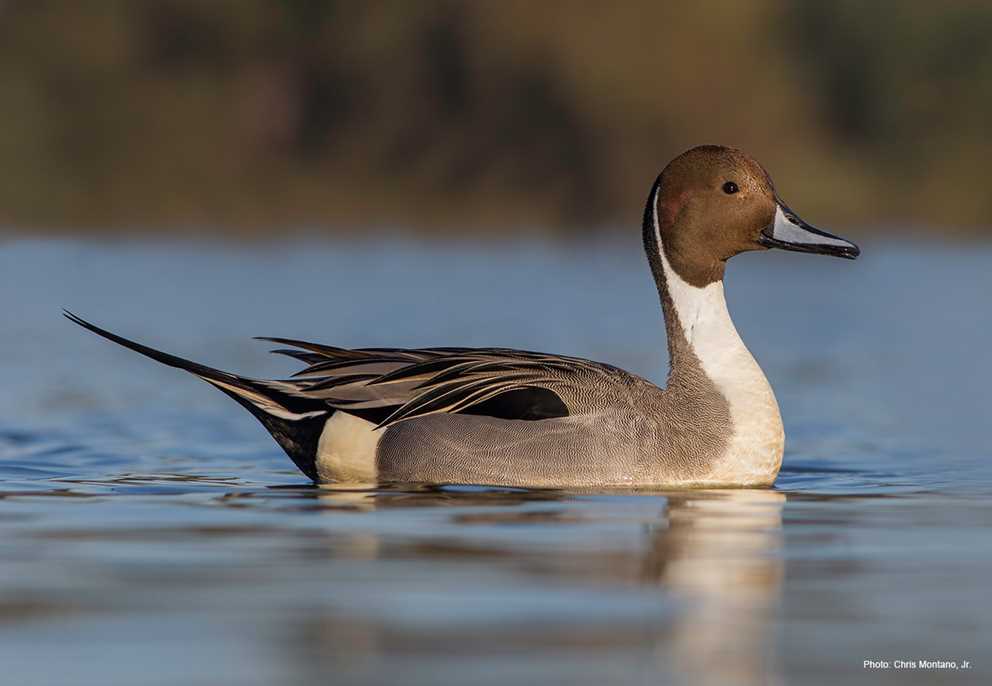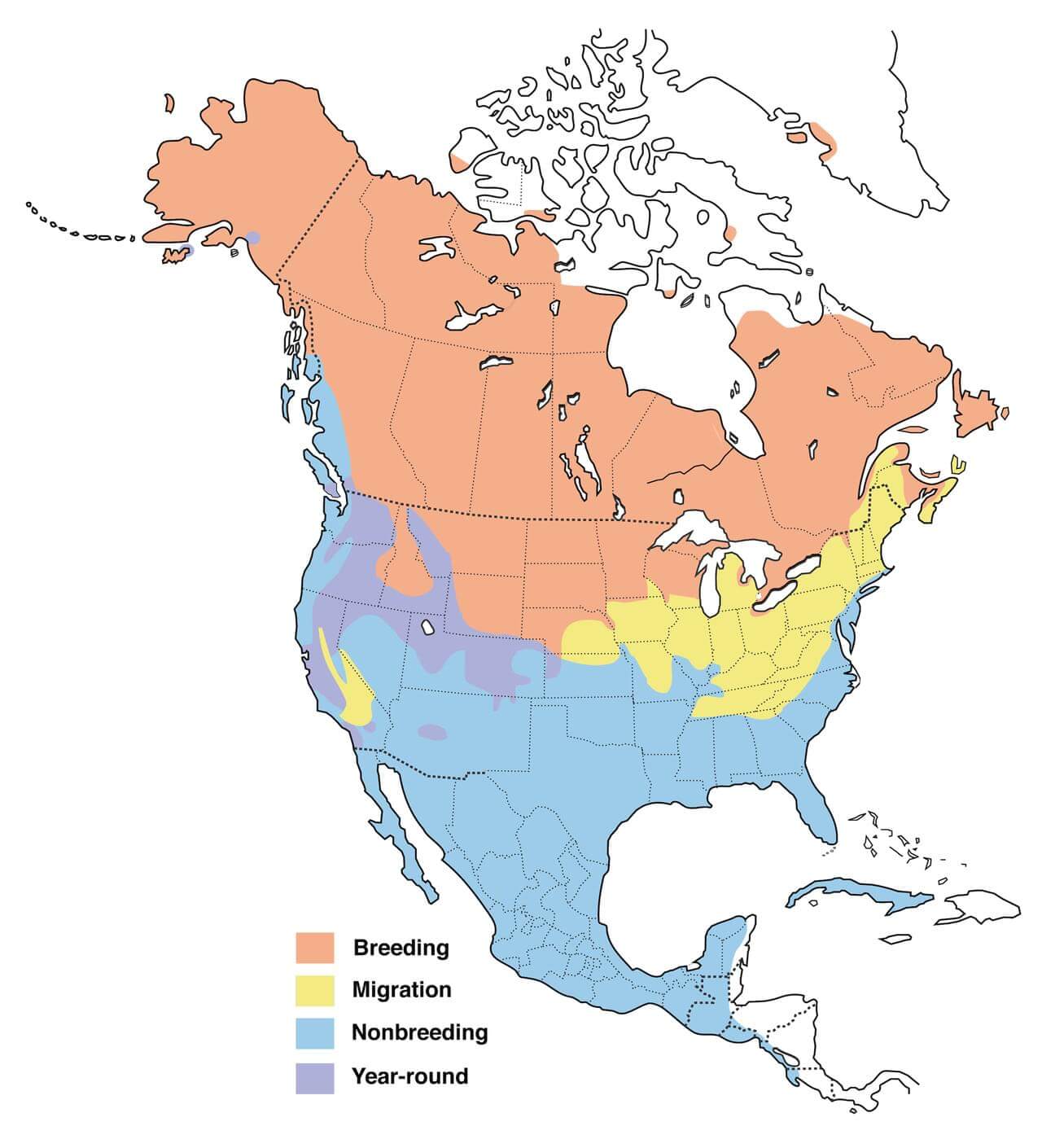Overview
The Northern Pintail is a large dabbling duck with a long slender appearance and has a circumpolar distribution that includes most of North America and Eurasia, and wintering areas in Africa. In North America, the core of its breeding range is Alaska and the Prairie Pothole Region of the Northern Great Plains. Its wintering range in North America extends from coastal British Columbia to California and east across the southern half of the United States to the Atlantic Coast. It also winters in all of Mexico and Central America south to Columbia. Northern Pintails predominantly use freshwater wetlands throughout their range, though in coastal areas of the United States and Mexico they also use brackish wetlands.
Northern Pintail males in alternate plumage are unmistakable, with a chestnut head and back of the neck, slender long pale bluish-gray bill with a black saddle, white stripes that extend from the back of head down the neck, where they join a white breast and belly. The back and flanks appear grayish. They show white at the rear of the flanks, and have a black rump and vent, and a grayish tail with two notably long black central rectrices for which they are named. Females and males in basic plumage are mottled brown.
Description
Key Identification Features:
- Northern Pintail males in alternate plumage have a chestnut head and back of the neck, a slender bluish gray bill, white stripes that extend from the back of head down the neck, where they join a white breast and belly. The back and flanks are grayish and have a black rump and a grayish tail with two notably long black central rectrices for which they are named.
- Females and males in basic plumage are mottled brown. The head is lighter brown and the bill is bluish gray. The belly is white, and rump and tail are both mottled brown.
- Males in basic plumage can be separated from females by the bill, which is bluish gray with a central black saddle in males, and grayish blue with no prominent saddle in females.
Male/Female Average Length and Weight
- Weight: Males 1.3–2.8 lbs.; Females 1.5–3.0 lbs.
- Wingspan: Males 9.6–11.8 in.; Females 9.0–11.0 in.
Male Identification:
- Alternate (Breeding) Plumage: Northern Pintail males in alternate plumage are unmistakable, with a chestnut head and back of the neck, slender long pale bluish-gray bill with a black saddle, white stripes that extend from the back of head down the neck, where they join a white breast and belly. The back and flanks appear grayish, and in hand show fine gray vermiculation. The tertials are centrally black and edged in white, yielding a broad striped appearance. They show white at the rear of the flank or side, and have a black rump and vent, and a grayish tail with two notably long black central rectrices for which they are named. The legs and feet are gray. Hunters often encounter males in the early portions of hunting seasons that still have basic plumage aspects that make them appear similar to females. They can be distinguished by bill color and wing and speculum coloration, with the speculum being much brighter green.
- Basic Plumage: Females and males in basic plumage are mottled brown. Males in basic plumage can be separated from females by the bill, which is bluish-gray with a central black saddle in males, and grayish-blue with no prominent saddle in females.
Female Identification:
- Alternate (Breeding) Plumage: Females are mottled brown overall, with a lighter brown to tan head, white belly, and the legs and feet are gray. The wing is mottled brown, has a white leading and trailing edge on the speculum, with is brownish with greenish or coppery iridescent overtones, but not nearly as green as in males.
- Basic Plumage: Females and males in basic plumage are mottled brown.
In-Flight Identification:
- In flight, the wing is gray-brown, with a green speculum, an anterior rusty-orange edge, and a posterior white edge in males. The female wing is similar, except it has a white anterior and posterior edge.
Vocalizations:
- Males give a whistling “whee” often in two consecutive notes.
- Females give a variation of a short, low “kuk” and may also give a similar call in a series.
Similar Species:
Habitat Preferences
- Breeding: Northern Pintails prefer shallow ephemeral to semi-permanent freshwater wetlands in open country with short vegetation for breeding habitat.
- Migration and Wintering: They prefer freshwater emergent wetlands and will also use brackish wetlands in coastal areas. Pintails also forage in harvested grain fields in migration, and in flooded rice fields where they overlap with their winter range.
Foraging Habits and Diet
- Northern Pintails prefer seeds and grains, tubers, and vegetative parts of various aquatic plants.
- Breeding Season: Spring and nesting season diets shift to more invertebrates, especially in females to support egg production, and typically will average 35 to 65 percent invertebrates.
- Migration and Winter: Their winter diet consists of 80 to 90 percent seeds and vegetation.
Breeding Habits
- Monogamy: Northern Pintail are seasonally monogamous. Pair formation is in fall or early winter, with bonds maintained through winter into the incubation period.
- Nest Location: Nests on the ground in short vegetation or in the open less than 1.2 miles from water. Northern Pintails often nest in tilled cropland making them susceptible to destruction from farm equipment.
- Clutch Size: 7 to 8 eggs. The eggs are pale olive green to greenish buff to pale olive buff, elliptical, sub-elliptical, to long-oval, and are 1.9–2.4 by 1.4–1.7 in. The incubation period is about 21 to 25 days. Renesting frequency is typically very low but occurs if seasonal or temporary wetland conditions persist later into the breeding season.
Migration and Distribution
- Fall Migration: Northern Pintails in North America are late summer to early fall migrants, often one of the first species to depart breeding areas in August or early September. They arrive in wintering areas as early as early September, and most are in wintering areas in October and November.
- Spring Migration: They also are early spring migrants departing winter areas in February with arrival on breeding areas in the Prairie Pothole Region in mid-March, and Arctic nesting areas by late April or early May.
Conservation Status
- IUCN Status: Least Concern
- Population Status: The estimated breeding population has declined from an estimated 9 to 10 million in the 1950s to around 2.2 million in 2024. The USFWS Waterfowl Population Status, 2024, estimated a breeding population of about 2,219,000 in spring of 2024, and the long term average is 3,842,000.
- Conservation Concerns: Drainage of wetlands and changing agricultural practices are present challenges. Switching from summer fallow (a rotation in which fields were harvested in fall, left fallow the subsequent spring and summer) to annual cropping across much of the Prairies disrupts nesting.
- Conservation Focus: Wetland restoration, protection, and integrating waterfowl management with farming practices are actions being taken in breeding areas in addition to enhancing wintering habitats.
Harvest Information
- An average of 346,975 Northern Pintail were harvested annually across the US from 2019 to 2022.
- Northern Pintail harvest is typically highest in the Pacific Flyway, accounting for 40 to 50 percent of the total US harvest.
- The top three harvest states during the 2019 to 2022 hunting seasons were California (338,655), Texas (154,153), Oregon (105,968).









